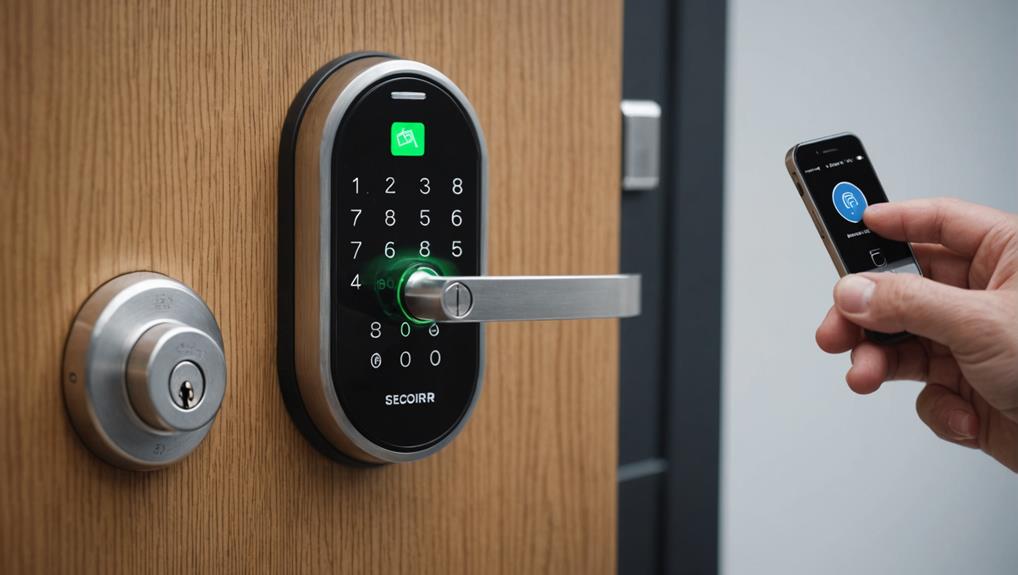Explore how lock security has drastically evolved with technology, revolutionizing how you protect your possessions and spaces. From traditional mechanical locks vulnerable to picking, to key-based systems offering customization and increased resistance, to electronic keypads with advanced authentication methods for enhanced security, the game has changed. Biometric access control provides secure entry using unique biological traits, while smart locks enable remote control via smartphones. The future holds promises of biometric authentication advancements like multi-modal recognition and integration with IoT devices, machine learning algorithms, and blockchain technology for maximum safeguarding.
Key Takeaways
- Traditional locks relied on mechanical mechanisms vulnerable to picking; modern locks integrate advanced technology for enhanced security.
- Electronic keypads offer robust security features, wireless connectivity, and real-time access updates, replacing traditional locks.
- Biometric access control utilizes unique biological traits, like fingerprints and facial recognition, for secure and convenient authentication.
- Smart locks provide remote access, encryption, and integration with smart home devices, revolutionizing security management.
- Future trends include biometric innovations, IoT integration, machine learning algorithms, blockchain, and quantum cryptography for heightened security measures.
Traditional Lock Mechanisms

Exploring the evolution of lock security begins with understanding traditional lock mechanisms. Traditional locks have been relied upon for centuries to secure homes, valuables, and more. These locks operate using mechanical components like pins, tumblers, and levers.
The most common type is the pin tumbler lock, where a key lifts the pins to align them perfectly, allowing the lock to turn. Tumbler lock mechanics play a significant role in how these locks function effectively. Traditional locks are known for their reliability and simplicity. However, they're susceptible to picking and bumping techniques, making them less secure compared to modern locks.
Modern locks, on the other hand, utilize advanced technology such as electronic keypads, smart cards, and biometric scanners. These locks offer enhanced security features like audit trails, remote access control, and multiple user access.
While traditional locks have their charm and are still widely used, modern locks provide a higher level of security and convenience. As technology continues to advance, the evolution of lock security will likely lean more towards these modern systems for increased protection and ease of use.
Key-Based Systems
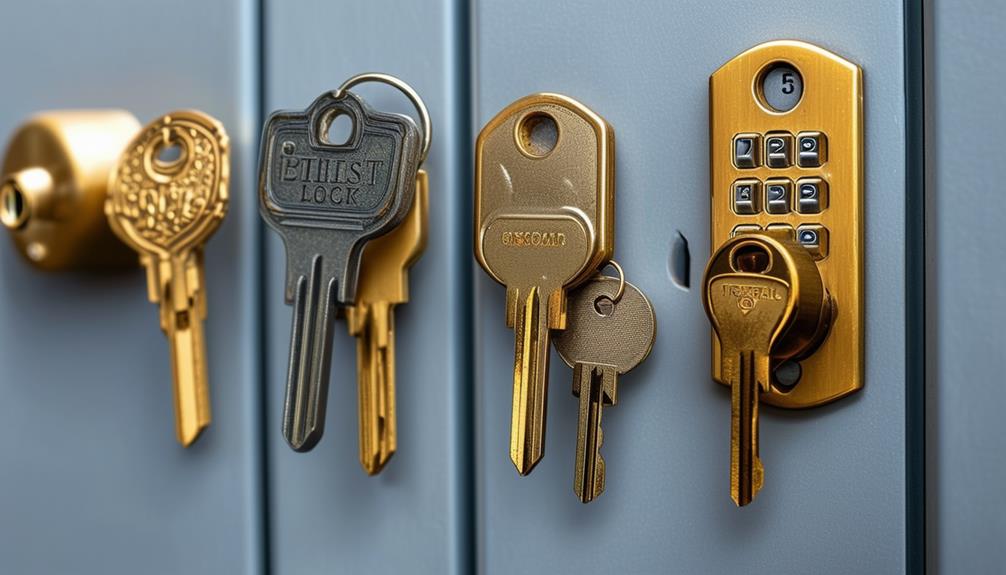
As you consider the evolution of lock security, it is crucial to explore the domain of Key-Based Systems. Key-based systems have played a pivotal role in the evolution of lock security, offering a secure and straightforward way to control access to buildings and assets. These systems rely on physical keys that align with specific lock mechanisms to grant entry. Let's examine a comparison between traditional lock mechanisms and key-based systems:
| Traditional Lock Mechanisms | Key-Based Systems |
|---|---|
| Often use basic pin tumbler mechanisms | Utilize unique key shapes for enhanced security |
| Vulnerable to picking and bumping | Provide increased resistance to unauthorized entry |
| Limited key variations | Offer a wide range of key options for customization |
| Require regular rekeying for security purposes | Allow for easy key replacement without altering the entire lock system |
The evolution of lock security has seen key-based systems evolve to provide better protection against unauthorized access while offering convenience and flexibility in key management.
Electronic Keypads
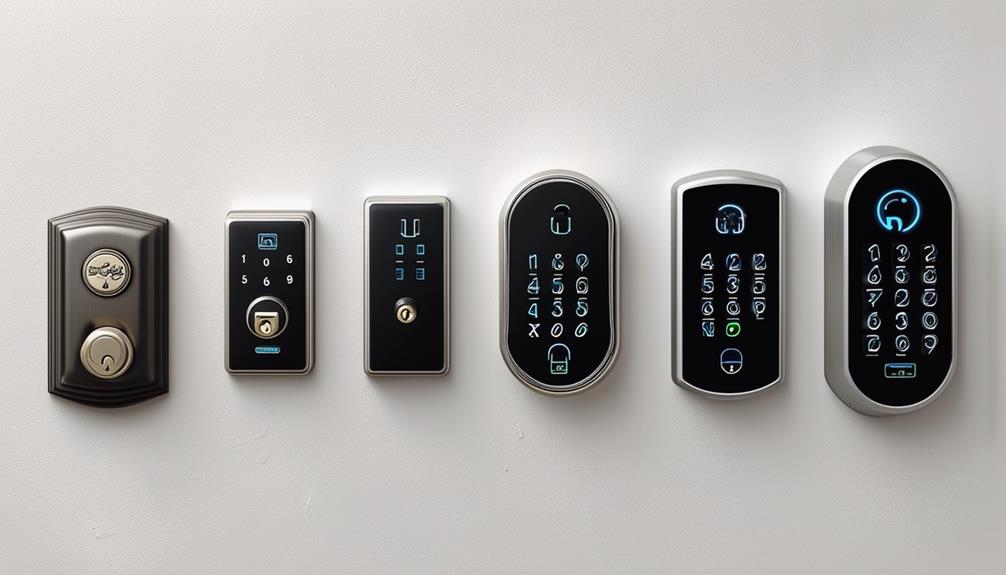
Let's talk about the advancements in keypad technology and how electronic keypads are integrating robust security features to enhance the protection of your property.
These keypads are becoming more sophisticated, offering innovative solutions to keep your belongings safe. With the evolution of electronic keypads, you can expect a higher level of security and convenience in accessing your spaces.
Additionally, the introduction of advanced authentication methods has further strengthened these systems, allowing for enhanced protection against unauthorized access.
As technology continues to improve, the reliability and functionality of electronic keypads will only get better, ensuring peace of mind for users.
Keypad Technology Advancements
Amidst the rapid technological advancements in the security industry, electronic keypads have emerged as a pivotal component in enhancing lock security. Keypad technology advancements have revolutionized how we secure our homes and businesses. Traditional locks with keys are being replaced by electronic keypads that offer convenience, flexibility, and heightened security.
One key advancement in keypad technology is the integration of biometric features, such as fingerprint recognition. This innovation guarantees that only authorized individuals can access a particular space, adding an extra layer of security beyond traditional PIN codes.
Additionally, modern electronic keypads often come equipped with touchscreen displays, making them user-friendly and sleek in design.
Wireless connectivity is another notable advancement in keypad technology. With the ability to connect to smartphones or home automation systems, users can remotely monitor and control access to their properties.
This feature enhances convenience and allows for real-time updates on who's entering and leaving a premises.
Security Features Integration
The integration of advanced security features into electronic keypads enhances the overall protection and accessibility of modern locking systems.
These keypads, equipped with cutting-edge technology, offer a higher level of security by incorporating features such as biometric scanners, proximity sensors, and encryption protocols.
Biometric scanners, for instance, guarantee that only authorized individuals can access a space by requiring a fingerprint or retina scan.
Proximity sensors detect when someone is near the keypad, prompting it to activate and authenticate the user quickly.
Encryption protocols safeguard the communication between the keypad and the central system, preventing unauthorized access or tampering.
Biometric Access Control
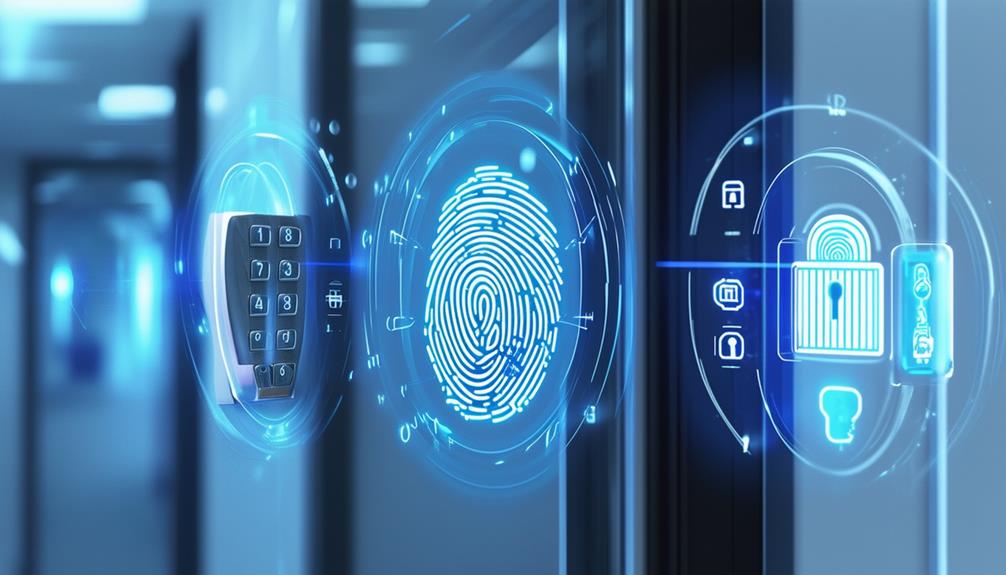
Now, let's introduce you to the world of Biometric Access Control.
Biometric authentication methods like fingerprint, iris, or facial recognition offer a more secure and convenient alternative to traditional keys.
These advanced methods, such as those found in the popular Bluetooth lock options, enhance security by ensuring that only authorized individuals can gain access.
As technology advances, we can expect to see even more innovative biometric solutions shaping the future of access control systems.
Biometric Authentication Methods
Biometric authentication methods, specifically in the form of biometric access control, have emerged as a cutting-edge solution in enhancing lock security.
Here's what you need to know about biometric authentication methods:
- Unique Identification: Biometric authentication relies on unique biological traits like fingerprints, facial features, or iris patterns for identification.
- High Security: Biometric data is difficult to replicate, providing a high level of security against unauthorized access.
- Convenience: Users no longer need to remember passwords or carry keys; access is granted through their unique biometric markers.
- Real-Time Authentication: Biometric systems offer quick and accurate verification, minimizing the time taken to grant access.
- Multi-factor Authentication: Combining biometric data with other authentication methods like PINs enhances security by adding layers of protection.
Incorporating biometric authentication methods into lock systems offers a secure and efficient way to control access.
This modern approach to security is revolutionizing traditional lock systems, making them more reliable and convenient for users.
Advantages Over Traditional Keys
As lock security continues to evolve, the shift towards biometric authentication methods brings a host of advantages over traditional keys. Biometric access control, using unique biological traits such as fingerprints or retina scans, offers heightened security compared to conventional keys. Unlike keys that can be lost, stolen, or duplicated, biometric data is unique to each individual, reducing the risk of unauthorized access.
Additionally, the evolution of locksmith tools has enabled seamless integration of biometric systems into various entry points, making them more convenient and efficient for users.
With biometric authentication, there's no need to carry keys around, eliminating the possibility of misplacement or theft. This advanced technology also provides a faster and more accurate way of verifying identity, enhancing overall security measures.
Moreover, the evolution of locksmith tools has made it easier to install and maintain biometric systems, ensuring reliable access control for homes, offices, and other facilities. Embracing biometric access control not only enhances security but also simplifies the way we interact with our surroundings.
Future Biometric Innovations
With advancements in technology rapidly shaping the future of security measures, the domain of biometric access control is poised for groundbreaking innovations.
Biometric innovations are revolutionizing the way we secure our spaces, offering heightened levels of security and convenience. Here are some key advancements to look out for:
- Multi-Modal Biometrics: Combining multiple biometric identifiers such as fingerprints, facial recognition, and iris scans for enhanced security.
- Behavioral Biometrics: Utilizing unique behavioral patterns like typing speed and gait recognition for authentication.
- Continuous Authentication: Constantly verifying identity throughout a session using biometric data to prevent unauthorized access.
- Biometric Wearables: Integrating biometric sensors into wearables like smartwatches for seamless authentication.
- 3D Biometrics: Utilizing three-dimensional facial recognition and vein patterns for extremely accurate identification.
These biometric innovations are reshaping the landscape of security, offering not only heightened protection but also a more user-friendly experience.
Stay tuned for these exciting developments in the world of biometric access control.
Smart Locks Integration
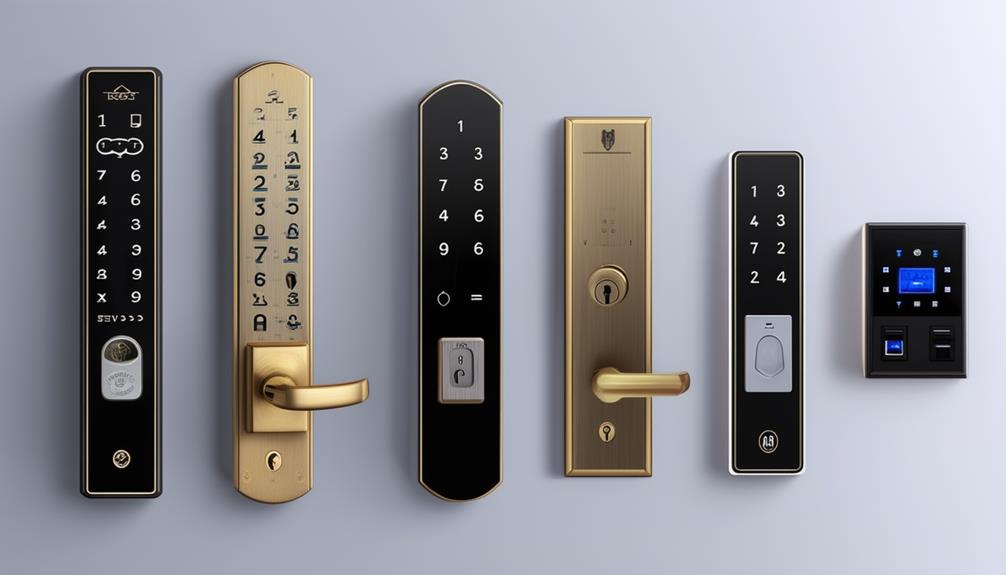
Over the past few years, the integration of smart locks has rapidly transformed the landscape of home security. Smart locks are devices that can be controlled remotely through a smartphone or computer, allowing you to lock and open your doors from anywhere.
One of the key benefits of smart locks integration is the convenience it offers. You no longer need to worry about carrying keys or making copies for family members; you can simply provide them with access through the smart lock system. Additionally, features such as robust encryption and tamper alerts enhance security measures, ensuring that your home remains protected.
Moreover, smart locks provide an added layer of security through features like real-time notifications when someone enters or exits your home. This can give you peace of mind knowing who's accessing your property at all times.
Additionally, the ability to integrate smart locks with other smart home devices, such as security cameras and alarms, creates a thorough home security system that works together seamlessly to keep you and your loved ones safe.
Future of Lock Security
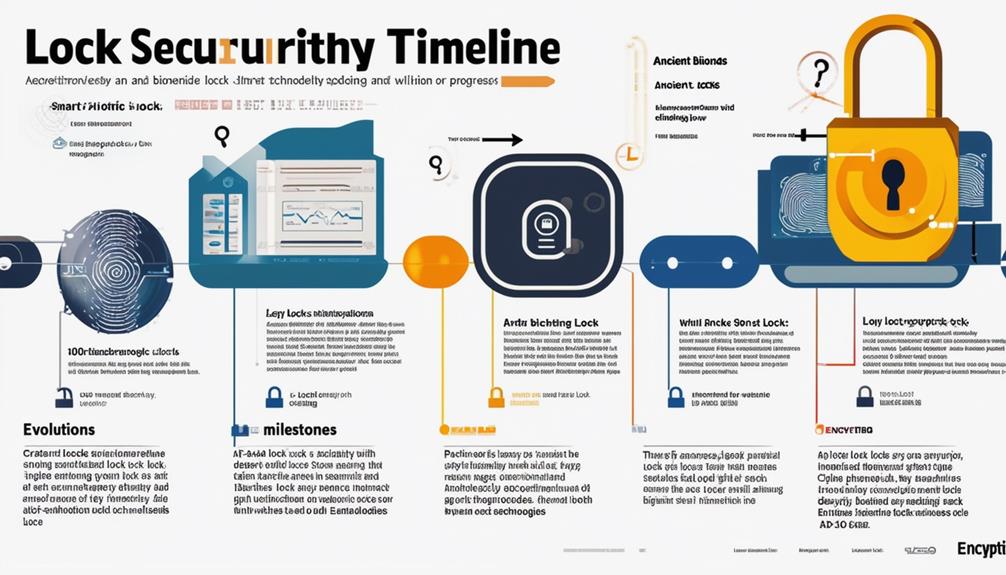
The rapid advancements in technology have considerably impacted the evolution of lock security, paving the way for innovative solutions that go beyond traditional locking mechanisms.
As we look towards the future of lock security, several exciting trends are emerging:
- Biometric Authentication: Expect to see increased use of fingerprints, facial recognition, and even iris scans to enhance security measures. This aligns with the rise of high-security locks that utilize advanced technology for robust protection against unauthorized access.
- Internet of Things (IoT) Integration: Locks will be interconnected with other smart devices, allowing for seamless automation and control.
- Machine Learning Algorithms: Lock systems will become smarter, learning from user behavior to enhance security protocols.
- Blockchain Technology: Utilizing decentralized ledgers to guarantee maximum security and prevent tampering with lock systems.
- Quantum Cryptography: The use of quantum principles to create virtually unhackable encryption methods for locks.
These trends indicate a future where lock security isn't only robust but also adaptive and highly sophisticated, providing users with unparalleled peace of mind.
Frequently Asked Questions
Can Locks Be Hacked Remotely With Advanced Technology?
Yes, locks can be hacked remotely with advanced technology.
Hackers can use various methods to breach electronic locks, like exploiting vulnerabilities in the system or using hacking tools to override security measures.
It's important to stay informed about the latest security threats and take necessary precautions to protect your belongings.
Upgrading to more secure locking systems and regularly updating software can help prevent remote hacking attempts.
Are Biometric Locks Easily Fooled by Duplicates or Fakes?
If you're wondering about biometric locks, you might be curious if duplicates or fakes can easily fool them.
Well, here's the scoop: biometric locks are generally quite secure against duplicates or fakes.
Because they scan unique physical characteristics like fingerprints or retinas, it's highly unlikely that someone could trick these locks with a copy.
How Do Smart Locks Handle Power Outages or Malfunctions?
Smart locks typically have backup power options like batteries to guarantee continued operation during power outages.
In case of malfunctions, some models allow manual key access as a fail-safe. These features provide peace of mind and guarantee that you can still access your home even if there are power disruptions or technical issues.
Can Electronic Keypads Be Compromised by Skilled Hackers?
Electronic keypads can potentially be compromised by skilled hackers through various methods such as brute force attacks or exploiting vulnerabilities in the system.
It's important to stay informed about security measures and regularly update your system to reduce these risks.
Implementing additional layers of protection, like two-factor authentication, can also help enhance the security of electronic keypads against potential hacking attempts.
Will Future Lock Systems Rely Entirely on Biometric Data for Security?
In the future, lock systems might primarily use biometric data for security. Biometrics offer a high level of personalization and security, making it harder for unauthorized access.
However, it's crucial to keep evolving security measures to stay ahead of potential threats. By combining biometrics with other advanced technologies, future lock systems can offer even stronger protection for your belongings and property.
Always stay alert to new innovations in lock security to safeguard your assets effectively.
Conclusion
As technology continues to advance, the evolution of lock security has transformed from simple key-based systems to sophisticated biometric access control and smart locks integration. Like a chameleon adapting to its environment, lock security has seamlessly blended traditional mechanics with cutting-edge technology to provide a seamless and secure solution for protecting what matters most. The future of lock security is bright, with endless possibilities for innovation and enhanced protection.

